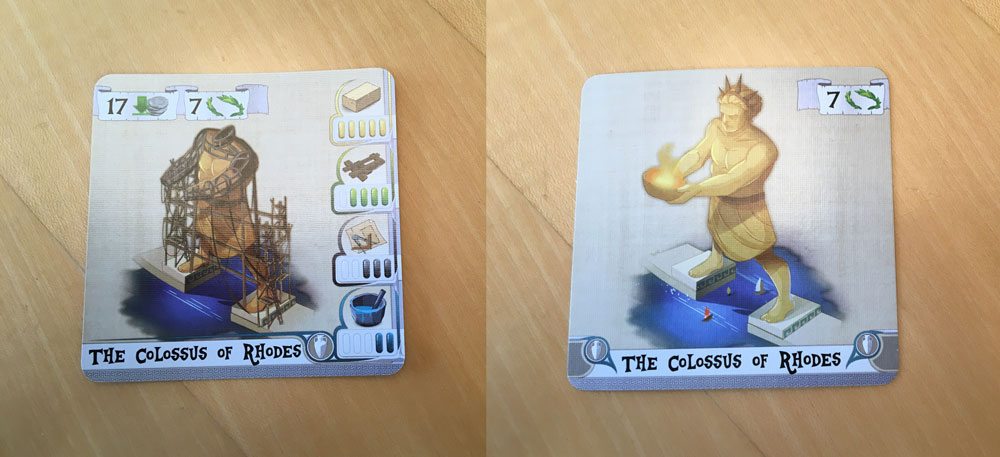Do you have what it takes to be the greatest builder of all time? You’ll need workers, resources, and be able to overcome challenges to build the Colossus of Rhodes, the Lighthouse of Alexandria, the Sphinx, … and the camel stables.
Summary
The Builders: Antiquity is a small box card-drafting and set-collection game for 2-4 players, aged 10 and up. It plays in about 30 minutes and is the second Builders game from Frédéric Henry (The Adventurers, Timeline).
Components
This is a small box game with a sub-$20 retail price, but besides a really great game, you get plenty for that price. The game comes in a pressed metal tin, which is fairly impressive. Inside, you’ll find:
- 37 regular sized playing cards consisting of:
- 18 workers
- 6 prisoners
- 4 tools
- 4 loans
- 4 universities (these cards are transparent like Gloom cards)
- 1 starting player card
- 33 larger, square cards
- 29 buildings
- 4 machines
- 40 plastic coins (23 silver colored worth one Sesterces and 17 gold colored worth 5 Sesterces)
- 1 rulebook
The artwork and quality of the cards is all very nice and the paper stock has a linen finish. While the coins are simple plastic, the transparent university cards are a nice touch.
Setup and Gameplay
At the top of the playing area, four piles are dealt out, one each for prisoners, loans, tools, and universities. Beneath that, the Building cards are shuffled and set construction side up. The first five Building cards are dealt out as the available pool. Next, the workers are given the same treatment: shuffled and five dealt for the available pool. Worker cards are double-sided but identical on each side. Each player is given an apprentice (any extras are shuffled into the worker deck) and 10 Sesterces. A first player is chosen and the game is ready to begin.
On a player’s turn, he has three free actions to spend. Additional actions can be purchased for 5 Sesterces each. A player can:
Start Construction: Take a building card(s) and place it, construction side up, in front of you. Immediately refill the open space in the available Buildings from the deck. On the construction side of the card, Buildings show the resources required to complete them, how many Sesterces they will pay out on completion, and the number of Victory Points they are worth at the end of the game.

Recruit a worker: This action is completed the same as with Buildings, but with workers. Worker cards show the number of resources that worker produces, along with the cost of sending him to work.
Make an Investment: There are four types of investments to make. First, for seven Sesterces, a worker can buy a prisoner. These cards can be sent to work at no cost (except the price of taking an action). Prisoners cannot hold a tool or be educated. Prisoners can be freed as an action, but then you must pay to send them to work. However, any unfreed prisoners at the end of the game will cost you in a lost Victory Point. Second, for two Sesterces, you can purchase a tool, which you can then send to a job with a worker (and augment their work) at no additional cost. Third, you can take out a loan. You get 10 Sesterces, but it costs 15 Sesterces to pay it back and any unpaid loan at the end of the game will cost you two Victory Points. Finally, you can educate a worker by paying seven Sesterces. When you do this, you place a clear university card over an existing worker. It enhances his ability to produce one of the four resources. There is only one university and tool card for each of the four resources (stone, wood, architecture, and decoration).

Send a worker to work: Pay the cost on a worker and send him to work. When you do this, his resource production is applied toward a Building’s construction. The worker cannot leave the project until it’s finished and some buildings may require a number of workers to complete. Sending a worker to a Building costs a single action, but sending a second worker in the same round will cost two additional actions. Sending a third costs an additional three actions, and so on. Additional actions can be purchased each turn for 5 Sesterces each. You can send two workers to two different Buildings for one action each.
Take Sesterces: Spend one action, get 1 Sesterce. Spend two actions, get 3 Sesterces. Spend 3 actions, get 6 Sesterces.

At any point, a player can finish a Building at no action cost. Simply flip the card, take the Sesterces bonus and return the workers and any tools to that player’s available pool. In the Building deck, there are 4 machines, which are built just like the Buildings. However, when complete, they do not award Sesterces. Rather, they are added to the worker pool and can be used to build other Buildings. Machines also award end game Victory Points.
Play continues until a player reaches 17 Victory Points. Play continues until it becomes the first player’s turn again (so everyone gets an equal number of turns. Players get one more chance to free prisoners (5 Sesterces if they are out of actions) and pay back loans. Victory Points are tallied, Sesterces are added up at a value of 0.1 VP each. The highest total wins.
Verdict
I never played The Builders: Antiquity‘s predecessor, The Builders: Middle Ages, but it’s my understanding that this new version has fewer workers, but enables you to expand on them through the education/university cards, as well as adding prisoners and tools.
Still, walking into this game cold, I really enjoyed it. I am a big fan of small games and this slots into that niche very nicely. It tucks away in a backpack and its tin protects its contents. It’s simple to setup and play and everything looks really nice. I am especially fond of the “purchase an extra action” rule. With a good enough stockpile of cash at the end, you can work your way into first place with a little thought and luck. Without the rule, the game would not be nearly as good. The rule radically affected the outcome of more than one game for us.
Workers are available in four different varieties – apprentices, laborers, craftsmen, and masters. Each has a different cost to send to work, but their output corresponds. Is it worth it to get just masters for fast completion, laborers for the low cost, or a combination of both? Whats more, players have to think about which Buildings to construct. Some have big cash rewards, but low VPs.
There are some other tough decisions you have to make too. Actions are limited and, although you can buy more, you have to save your money too since sending workers to work costs money and resources are pretty limited. Bad planning can mean looking at your workers you’ve already sent out and fretting about how you are going to come up with more money or workers to complete projects before the game ends. It’s an impressive amount of strategy for a small game.
In some ways, the game is similar to last year’s hit game, Splendor (also an Asmodee game), where players collect resources to purchase cards worth resources and/or Victory Points. I see the similarities, but while I enjoy Splendor‘s incredibly fast play, I almost like The Builders: Antiquity more. I feel like this game has more strategy and is a bit more enjoyable.
In fact, as a small game, The Builders: Antiquity plays as well as a game many times its size. It’s very enjoyable and worth checking out, especially at its very affordable price point. The Builders: Antiquity is available now.
Disclosure: GeekDad was sent a review copy of this game.







Awesome! Looking into picking this up for Christmas.
Also, the link to the game (at the bottom of the post) doesn’t work. Just FYI.